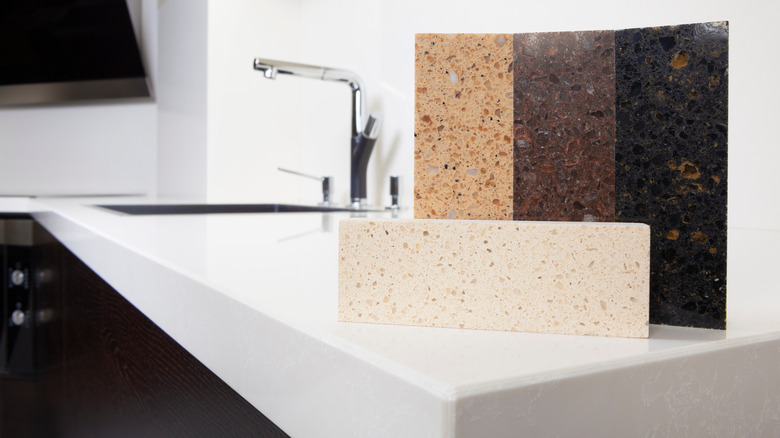Countertop Edge Options That Are The Easiest To Clean
The profile of the front edge is an often overlooked consideration in finding the perfect kitchen counter. Countertop edge styles are often an afterthought amid discussions of natural vs manufactured materials, color and style, and other concerns. Counter edges are available in several varieties, from smooth and curved polished edges to crisp mitered corners that revel in right angles. Some edges come in between, including beveled and bullnose, while others flatter certain materials or design aesthetics. There's also the question of cleaning and maintenance, for which some edges — like eased and beveled — stand out by providing a smooth easy edge to wipe down and clean.
Practical reasons may also impact your choice of edges, including the layout of your kitchen and who uses it. Small children or pets may be a bad fit for sharper edge counters, while rounded edges will benefit a kitchen where tight space may have you bumping up against them more often. Other custom edges, while looking great might have a lot of cracks and nooks that make them harder to clean. Counters with richly textured rugged cuts can also be harder to maintain, harboring food, dirt, moisture, and bacteria.
The easiest countertops to clean
Some very popular countertop edges come with not only affordability and practicality in mind but are also far easier to clean and maintain. These include eased edge counters, which are square at the front face but curve softly at the edge. Square edges, which do not curve, meet at a right angle and are often used in more modern kitchens, where the lines are sharp and pronounced Eased edges allow you to wipe counters down completely with no spaces for dirt and bacteria to linger.
Square counters work similarly well, though, depending on the material, could harbor debris in spots where the materials and trim meet. A full slab of marble will have no gaps, but linoleum counters could have a seam where the trim begins. Beveled counters also offer a great option as well, since they are carved at more right angles, making the downslope of the top part easy to clean. This cut is great if you're looking for a modern look and easy cleanability, but want a softer option with less sharp unforgiving edges.
Hardest to clean
Custom edges can allow the character of the material, whether it's wood or stone, to shine through, exposing crevasses and veining not always as seen in smoother cuts, and giving a rustic vibe that befits many kitchen styles. However, these are often the worst edges to try to keep clean, as well as the most likely to suffer damage. While a smooth counter edge offers some protection against cracks and chips, custom rough edges have no protection. Often food bits, moisture, and dirty fingers can make this beautiful edging more hassle than it's worth.
While the smooth roundness of bullnose edges may seem like an excellent solution for both beauty and practicality, these edges can sometimes cause problems where they rest against the cabinets as they tend to channel liquid around and under. This can mean bacteria and moisture affecting your cabinet surfaces, too. A great alternative is a half-bullnose which is rounded on top but drops to a more right-angled cut at the bottom.


